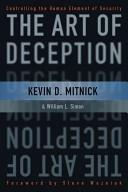Summary
The Art of Deception by Kevin Mitnick, one of the world’s most notorious former hackers, presents a gripping, real-world examination of social engineering—the manipulation of human psychology to gain unauthorized access to systems and data. Drawing from personal experience and detailed case studies, Mitnick exposes how security is often weakest not in code or infrastructure, but in people.
This book aims to make readers aware of how attackers exploit trust, ignorance, and routine behavior to bypass even the most sophisticated technical safeguards. Mitnick’s message is clear: to build a secure system, you must first understand the human weaknesses that threaten it.
Part I: The Human Factor
Mitnick begins by showing that most security breaches don’t rely on brute-force hacking or technical wizardry. Instead, they exploit the most fallible link in any system: the user.
What Is Social Engineering?
Social engineering refers to the psychological manipulation of people into performing actions or divulging confidential information. It is often a precursor to more technical intrusions and can occur via phone calls, emails, impersonations, or in-person interactions.
Mitnick emphasizes that social engineering works because:
- People inherently trust others
- Policies are often ignored or poorly understood
- Attackers exploit politeness, helpfulness, or fear
Core Tactics of the Social Engineer
- Pretexting: Creating a fabricated identity to manipulate targets (e.g., pretending to be IT staff).
- Phishing and Vishing: Using fake emails or phone calls to extract credentials.
- Dumpster Diving: Retrieving discarded documents or devices.
- Shoulder Surfing: Observing someone entering passwords or using secure terminals.
- Reverse Social Engineering: Creating a problem so that the victim asks the attacker for help.
Part II: The Art of the Attack
This section presents dozens of dramatized vignettes, each based on real events. These stories reveal how attackers:
- Exploit common behaviors (e.g., tailgating into secured areas)
- Manipulate bureaucracies and support desks
- Take advantage of trust in internal hierarchies
Examples
- The Trusted Insider: A consultant gains unauthorized access by claiming to be a new hire and invoking the name of a known executive.
- Help Desk Hack: An attacker convinces IT support to reset a password by referencing public information and feigning urgency.
- Phone Company Ploy: Using a false sense of authority, an attacker gets a telco employee to reveal call routing protocols.
Each story ends with a breakdown of what went wrong and what could have prevented it.
Part III: Raising the Bar
Mitnick transitions to prevention and outlines methods organizations can adopt to protect against social engineering threats.
Building a Human Firewall
Just as we install technical firewalls, we must train employees to act as a barrier against deception. Key practices include:
- Security awareness training
- Simulated phishing campaigns
- Mandatory policy enforcement
- Multi-factor authentication
Principles for Secure Behavior
- Verify identities before divulging information.
- Challenge unusual requests, even from apparent authority figures.
- Report suspicious behavior, even if it feels awkward.
- Limit access based on least privilege principles.
- Never trust unknown USB drives, emails, or links.
These habits can significantly reduce risk.
Red Teaming and Testing
Mitnick recommends hiring ethical hackers to test defenses through simulated social engineering attacks. These “red team” exercises:
- Reveal policy weaknesses
- Expose training gaps
- Help normalize defensive reflexes
Part IV: Mitigation Strategies
Organizational Policies
- Clear incident response plans
- Documented verification procedures
- Data classification systems
- Role-based access controls
- Audit trails and logging
These build a foundation of accountability and resilience.
Legal and Regulatory Measures
Many jurisdictions have laws related to data protection and breach notification (e.g., GDPR, HIPAA). These add external pressure to maintain strong defenses and document internal procedures.
Balancing Trust and Security
Excessive security can hinder productivity; too little creates vulnerability. Mitnick suggests aiming for:
- Minimal friction workflows
- Transparent communication of policy rationale
- Periodic reassessments of risk tolerance
The goal is a culture where security is a shared responsibility.
Psychological Triggers of Deception
Mitnick identifies recurring psychological levers used in attacks:
- Authority: People comply with those who appear powerful.
- Urgency: Crisis-driven requests reduce skepticism.
- Reciprocity: Offering a small favor can induce cooperation.
- Scarcity: Limited access can push rushed decisions.
- Liking: People trust those who mirror their behavior or values.
Understanding these triggers helps design better defenses and training.
The Human Operating System
Just as software can be patched, human systems can be updated through:
- Consistent training
- Organizational feedback loops
- Sharing breach post-mortems
- Rewarding proactive behavior
Security awareness must evolve with emerging threats and employee roles.
Final Lessons
- Technology alone won’t secure an organization; culture must do the rest.
- Social engineering is a powerful and persistent threat because it preys on human nature.
- Awareness, policy, and verification must become embedded habits—not checklists.
Mitnick closes by urging organizations to treat users as the first line of defense, not the weakest link, and to invest in their training and empowerment.
Why This Book Matters
The Art of Deception changed how people think about cybersecurity. It moves the conversation beyond firewalls and encryption toward human psychology and behavior. Mitnick, once a master manipulator of systems and people, uses his insights to promote stronger defenses and smarter decisions.
For security professionals, managers, and everyday users, the book offers compelling lessons, entertaining stories, and practical advice on how to see through deception and stop it before damage occurs.
TL;DR
Kevin Mitnick exposes the true threat to cybersecurity: people. Through real-world scenarios and sharp analysis, The Art of Deception reveals how social engineering exploits human behavior—and how awareness, training, and smart policy can protect against it.

